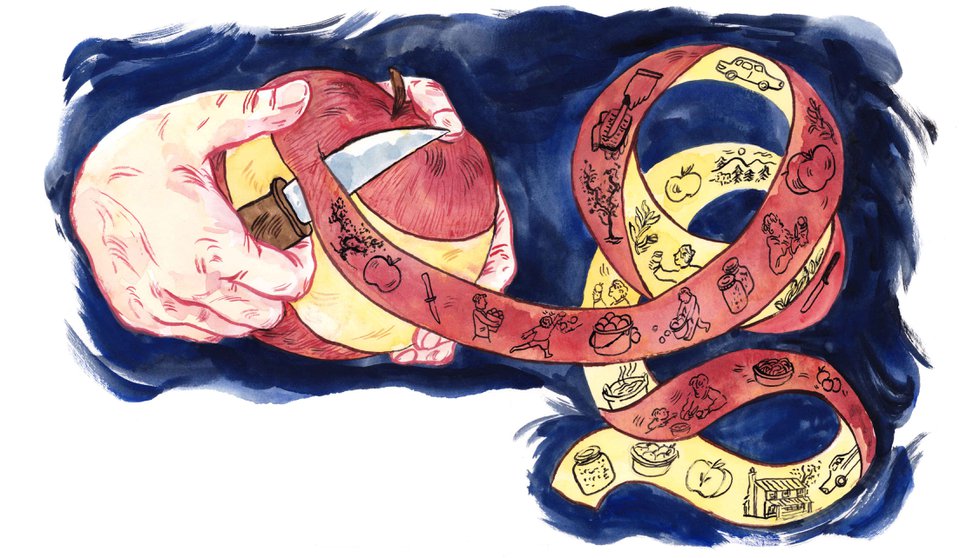She could peel and core an apple in under two minutes, lifting the skin with her paring knife to turn out a single, unbroken spiral. And on apple butter day, my Granna Shirley made mountains of them, an entire massif spreading across the kitchen counter. It takes bushels of apples; six of them one year, seven the next, and many hands to unravel the peels like a scarf, plunge out the cores, chop, and stir, almost constantly, for hours.
There’s no butter in apple butter. It’s more a cross between jam and high-octane applesauce. It originated in medieval Europe but became a Southern staple when the Pennsylvania Dutch brought it to western North Carolina after the Revolutionary War. Eventually, apple butter found its way to my grandparents’ log cabin in Wintergreen. The recipe had been passed down for centuries.
As autumn painted searing reds and golds along the Blue Ridge, our family would pile in the car, driving from North Carolina to Granna’s cabin, where an orchard stood in the back. The low-hanging apples were for the youngest cousins to pluck; the older ones got ladders and pickers. We’d fill the baskets and boxes as quickly as our boy cousins could ferry into the kitchen, broken plastic buckets and the same water-stained boxes from the year before overflowing with fruit, where they met Granna’s paring knife.

The peeled apples would be cored and chopped, then simmered on the stove for hours, well into the night. To the pot, Granna added cups of sugar and spices in tablespoons, precisely leveled. My aunts and uncles filled the kitchen, tying apron strings behind them, drifting in the corners until summoned by a wave of her demanding hand. The windows steamed up as the apples caramelized, perfuming the air with cinnamon, nutmeg, and cloves. Too young to wield a knife or stir the near-boiling pot, I joined my younger cousins in the dining room around a giant copper pot where we mashed and stirred our imaginary apple butter.
When my knife skills finally passed muster, I’d sit at the table with Granna Shirley, casting peels into a red plastic bowl. Mine always broke; a series of question marks. But even then, hers spooled out, perfectly intact. We talked about the birds at Wintergreen, how they were drawn to the sun porch, or the jars of vegetables she canned and pickled, lined up in neat rows on shelves in the basement.
When the fruits of Granna’s labor were canned and tucked safely in the cellar, three rows deep, we would leave with a catawampus car, the trunk so laden with filled-to-the-brim Mason jars that it nearly scraped the pavement. In the coming year, we would spread apple butter on every edible surface. “No,” I’d tell friends over the din of the school cafeteria. “It’s not actually butter.”
Then, like the fading ink of her recipe card, Granna Shirley began to forget. Before long, Granddad sold the cabin and they moved to be closer to us in North Carolina. Our Wintergreen years were over.
The North Carolina autumns didn’t quite compare to those in Virginia—there were no mountains in view, and the apples at the farmers market were never as tasty. But they marked the same moment for our family: apple butter season. Only now Granddad and Granna Shirley would arrive at my parents’ house, honking their horn all the way up our long driveway. The apples deemed worthy of apple butter were piled high in the cracked leather back seat of their car, which smelled of decades-old cigarette smoke, or rolling wildly under the passenger seat.
Once more, cousins, aunts, and uncles filled the kitchen with chatter and laughter. The metal lids of the Mason jars popped as the steam from the boiling water rose, tinkling like bells. The bowl of peelings taken out back, emptied a dozen times, a treat for the chickens.
Whether or not she knew where she was, or who we were, Granna Shirley was content at the kitchen table, peeling one apple after another, the peels piling up in the way only she could do.
Sylvie Baggett spent her summers in Wintergreen, where her grandparents lived in a historic cabin on a small apple orchard. She now resides in Brooklyn, New York, where she works as an editor.








